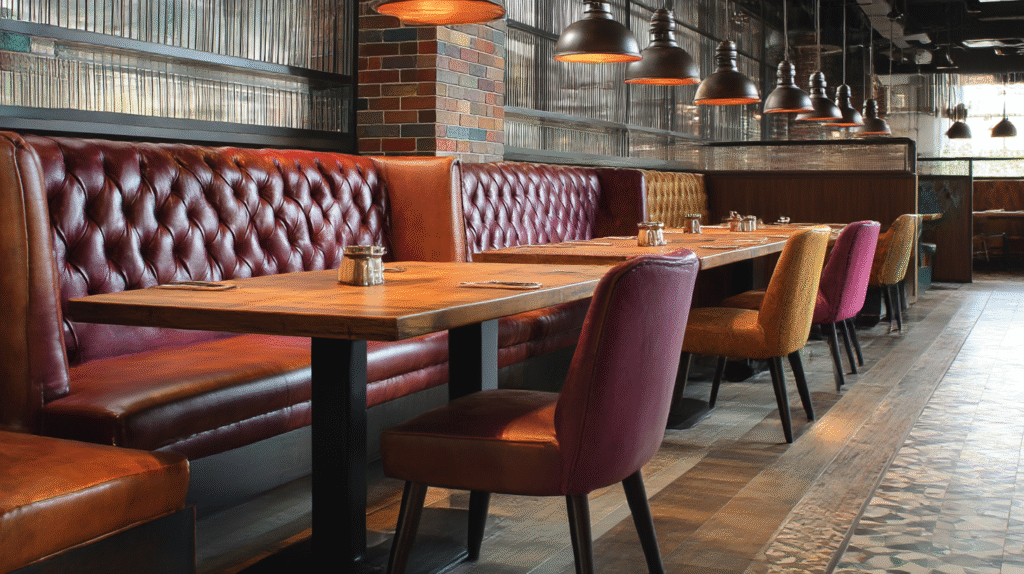Selecting the right restaurant furniture is crucial for balancing function, aesthetics, and longevity. Your choice impacts not only how your space looks, but also how it performs under daily wear and tear. Durable and stylish furniture contributes to customer comfort, brand identity, and long-term cost-efficiency. In this guide, we break down the essentials of choosing restaurant furniture that lasts, fits your theme, and elevates your dining environment.
Why Durability Matters When Choosing Restaurant Furniture
Durability is non-negotiable when it comes to restaurant furniture. Dining spaces experience high traffic, constant use, and regular cleaning, which can wear down lower-quality materials quickly. Sturdy, well-constructed furniture resists scratches, wobbles, and surface damage—ensuring your investment lasts for years. Durable furniture also ensures customer safety and reduces the frequency of repairs or replacements. Whether you run a casual cafe or upscale eatery, selecting furniture built for commercial use is essential. Look for reinforced joints, weight-tested frames, and heavy-duty finishes. Furniture that combines endurance with style not only stands up to rigorous use but also maintains a polished, professional appearance. In the long run, choosing restaurant furniture for its strength and longevity will save time, money, and stress.
Balancing Style and Function in Restaurant Furniture Design
Great restaurant furniture strikes a balance between style and functionality. While aesthetics play a huge role in shaping your restaurant’s ambiance, functionality ensures comfort and efficiency. For example, chairs should not only look good but also offer ergonomic support for guests. Tables must be visually appealing yet the right size and height for comfortable dining. Consider your restaurant’s concept—whether industrial, rustic, modern, or classic—and choose furniture that complements your branding. At the same time, avoid pieces that prioritize design over practicality, such as chairs with fragile materials or hard-to-clean surfaces. Stylish furniture that can withstand daily use will help maintain a cohesive, inviting environment while minimizing the need for frequent replacements. The most effective restaurant furniture adds both beauty and purpose to your space.
Top Materials for Long-Lasting Restaurant Furniture
The materials used in restaurant furniture greatly influence both durability and style. Wood is a popular choice for its warmth and timeless appeal, especially hardwoods like oak, maple, and beech. However, it requires proper sealing and care. Metal furniture—particularly aluminum and steel—is known for its strength and modern look, making it ideal for industrial or contemporary spaces. Plastic or resin chairs are lightweight, affordable, and easy to clean, often used in casual or outdoor dining. Upholstered seating adds comfort and sophistication but should feature stain-resistant, commercial-grade fabric or vinyl. When selecting materials, consider maintenance needs and how well they’ll withstand spills, scratches, and frequent use. Combining different materials can also create visual contrast while boosting functionality. Choosing high-quality, wear-resistant materials is key to ensuring your restaurant furniture stands the test of time.
How to Evaluate the Build Quality of Restaurant Furniture
Assessing build quality is essential when choosing restaurant furniture that will last. Start by checking the frame—solid wood or welded metal are strong indicators of longevity. Examine joints and connections; furniture with mortise-and-tenon or metal welds is generally more durable than those held together by staples or weak adhesives. Test stability by gently shaking chairs and tables—there should be no wobbling or creaking. For upholstered furniture, ensure tight stitching and high-resilience foam. The finish should be smooth, scratch-resistant, and sealed to protect against spills and wear. Commercial-grade furniture often includes certification or standards that confirm it’s suitable for restaurant use. Don’t be afraid to ask the supplier about testing, weight capacity, or performance guarantees. High-quality restaurant furniture is a long-term investment that provides lasting comfort and durability under daily pressure.
Design Tips for Matching Restaurant Furniture with Your Theme
Your restaurant furniture should seamlessly support your overall theme and brand story. Begin by defining your restaurant’s vibe—whether it’s upscale fine dining, rustic farmhouse, bohemian bistro, or sleek modern café. Then, choose furniture styles, materials, and colors that align with that concept. For example, distressed wood tables pair well with a country-style eatery, while clean-lined metal chairs fit perfectly in a contemporary setting. Use consistent colors and textures to tie different elements together. Don’t forget about lighting, flooring, and decor—your furniture should complement the entire design ecosystem. Mixing styles can work when done intentionally, like pairing vintage chairs with minimalist tables for an eclectic feel. The goal is cohesion—your restaurant furniture should look intentional, not mismatched. A well-designed space creates a memorable experience for diners and sets your restaurant apart from the competition.
Commercial vs. Residential: What Makes Restaurant Furniture Different
It’s important to understand the difference between commercial and residential furniture when shopping for restaurant furniture. While residential pieces may look appealing and cost less, they’re not built to handle the wear and tear of a busy dining environment. Commercial-grade furniture is specifically designed for strength, stability, and frequent cleaning. It meets stricter standards for safety, weight tolerance, and fire resistance. Commercial finishes are more durable, and fabrics are often stain-resistant and antimicrobial. Using residential furniture in a restaurant could lead to faster wear, safety risks, and costly replacements. Always verify with your supplier that the furniture is suitable for commercial use, especially for high-traffic areas like dining rooms and patios. Choosing proper restaurant furniture ensures not only a longer lifespan but also better performance and peace of mind.
Choosing Restaurant Furniture That Withstands Heavy Daily Use
Restaurants are demanding environments, and your restaurant furniture needs to keep up. Chairs are pulled in and out dozens of times a day, tables are subjected to spills, heat, and heavy dishware, and bar stools endure constant movement. Look for pieces rated for heavy-duty, commercial use. Reinforced joints, powder-coated metal, sealed woods, and water-resistant finishes all contribute to durability. Avoid fragile, decorative-only furniture that can’t withstand daily wear. High-traffic areas should use tougher materials like metal, laminate, or polypropylene. Furniture that is stackable or easy to move also makes cleaning and rearranging more efficient. Consider investing in protective accessories like chair glides and tabletop covers. Durable restaurant furniture not only protects your investment but also ensures guest satisfaction by providing sturdy, reliable seating every time.
How to Test and Maintain Durable Restaurant Furniture
Even the most robust restaurant furniture needs regular care to stay in great condition. Begin with a testing phase—before committing to a large order, sample a few pieces in your space. Assess how they hold up to spills, movement, and customer use. After purchase, establish a maintenance routine: clean surfaces daily with appropriate non-abrasive products, and perform weekly inspections for loose joints or damage. Use furniture pads to prevent floor scratches and seat cushions to reduce wear. Upholstered items should be vacuumed regularly and treated with fabric-safe cleaners. Outdoor furniture should be protected from harsh weather or stored indoors when not in use. Proper maintenance preserves your investment and extends the life of your restaurant furniture, keeping it looking sharp and functioning well for years.
Smart Buying Tips for Investing in Quality Restaurant Furniture
To make the most of your restaurant furniture investment, plan carefully and buy smart. Start by setting a realistic budget and allocating funds for quality over quantity. Consider how each piece will be used—choose heavy-duty tables and seating for busy dining areas, and invest in more decorative items for lower-traffic zones. Always purchase from reputable vendors who specialize in commercial-grade furniture, and don’t hesitate to ask for warranties, reviews, and performance certifications. Measure your space precisely before ordering, and factor in delivery, assembly, and lead times. If possible, request samples or test products in person. Buying in bulk often yields discounts, but only if you’re confident in the product. Remember: well-chosen restaurant furniture not only enhances your space but also saves money over time through reduced maintenance and replacement needs.
Conclusion: Create a Lasting Impression with the Right Restaurant Furniture
Choosing restaurant furniture is more than a design decision—it’s a strategic investment in your brand’s success. The right furniture enhances your space, supports daily operations, and delivers a comfortable, inviting experience for guests. By prioritizing durability and style, you ensure that your furnishings can withstand the pressures of a busy restaurant while still reflecting your unique identity. From material selection to layout planning and maintenance, every step matters. Whether you’re starting fresh or upgrading your dining space, a thoughtful approach to furniture selection can elevate your business, reduce long-term costs, and leave a lasting impression on every guest who walks through your doors.






